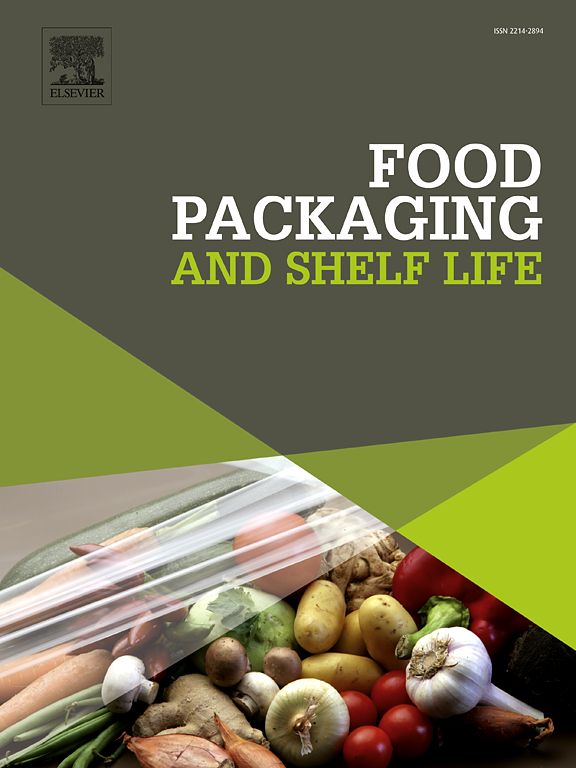绿液吹丝快速生产黄鳍金枪鱼保鲜用玉米蛋白/二氢槲皮素聚乙烯氧化膜
IF 10.6
1区 农林科学
Q1 FOOD SCIENCE & TECHNOLOGY
引用次数: 0
摘要
尽管有许多商业和政府举措,食品腐败和塑料包装污染持续严重影响人类健康和全球经济。采用绿色溶液吹丝(SBS)技术制备了玉米蛋白/聚氧聚乙烯/双氢槲皮素纳米纤维薄膜,并将其应用于黄鳍金枪鱼的保鲜。所得的纳米纤维膜具有优异的抗菌活性,以及较强的抗氧化和抗紫外线性能。此外,它还具有可生物降解性,符合对环境可持续包装解决方案日益增长的需求。此外,玉米蛋白和二氢槲皮素提高了薄膜的热稳定性,可能是通过氢键和各种相互作用。红外光谱(FTIR)和x射线衍射(XRD)分析证实了氢键的存在,并表明组分之间具有良好的相容性。TGA结果表明,ZPD膜的最大热降解温度(Tmax)比ZP膜高333.2 ~ 342.6℃。此外,SEM和XRD评估进一步证明了膜的结构完整性和增强的热稳定性。通过监测总挥发性碱性氮(TVB-N)、硫代巴比妥酸活性物质(TBARS)和总活菌数(TVC)等关键质量指标,评价该膜延长金枪鱼货架期的效果。结果表明,纳米纤维膜处理降低了TVB-N、TBARS和TVC的水平,显著减缓了鱼类新鲜度的恶化,并在4℃下保存了8天。该研究为提高食品安全,延长保质期,减少传统塑料包装对环境的影响提供了可行的方法。本文章由计算机程序翻译,如有差异,请以英文原文为准。
Rapid production of zein/polyethylene oxide film containing dihydroquercetin by green solution blow spinning for yellowfin tuna preservation
Despite numerous commercial and governmental initiatives, food spoilage and plastic packaging contamination persistently affect human health and the global economy significantly. In this study, a novel zein/polyethylene oxide/dihydroquercetin nanofiber film was developed using a green solution blow spinning (SBS) technique and applied to the preservation of yellowfin tuna. The resulting nanofibrous film demonstrated excellent antimicrobial activity, along with strong antioxidant and UV-blocking properties. Additionally, it exhibited biodegradability, aligning with the growing demand for environmentally sustainable packaging solutions. Moreover, zein and dihydroquercetin improved the thermal stability of the film, presumably via hydrogen bonds and various interactions. FTIR and XRD analyses validated the presence of hydrogen bonds and showed great compatibility among the components. TGA showed that the maximum thermal degradation temperature (Tmax, ranging from 333.2 to 342.6 ℃) was elevated for ZPD films in comparison to ZP film. Additionally, SEM and XRD assessments further illustrated the film's structural integrity and enhanced thermal stability. The effectiveness of the film in extending the shelf life of tuna was evaluated by monitoring key quality indicators, including total volatile basic nitrogen (TVB-N), thiobarbituric acid reactive substances (TBARS), and total viable count (TVC). The results showed that the nanofibrous film treatment decreased the levels of TVB-N, TBARS, and TVC, significantly slowing the deterioration of fish freshness and maintaining its quality for up to 8 days when stored at 4 ℃. The study offers a viable approach for improving food safety, prolonging shelf life, and reducing the environmental effects of traditional plastic packaging.
求助全文
通过发布文献求助,成功后即可免费获取论文全文。
去求助
来源期刊

Food Packaging and Shelf Life
Agricultural and Biological Sciences-Food Science
CiteScore
14.00
自引率
8.80%
发文量
214
审稿时长
70 days
期刊介绍:
Food packaging is crucial for preserving food integrity throughout the distribution chain. It safeguards against contamination by physical, chemical, and biological agents, ensuring the safety and quality of processed foods. The evolution of novel food packaging, including modified atmosphere and active packaging, has extended shelf life, enhancing convenience for consumers. Shelf life, the duration a perishable item remains suitable for sale, use, or consumption, is intricately linked with food packaging, emphasizing its role in maintaining product quality and safety.
 求助内容:
求助内容: 应助结果提醒方式:
应助结果提醒方式:


